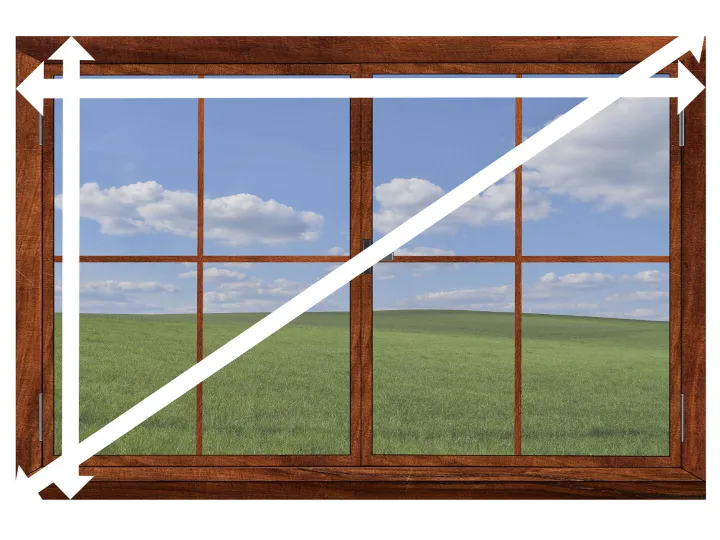Measuring for a new window
Measuring for a new replacement window is not difficult, and you should have no problems, provided you take care and proceed in an orderly way. However, if you don't get the correct measurement, you could end up with a window that doesn't fit, which is embarrassing and expensive.
Before you start, it's a good idea to have a tape measure, notebook, and spirit level on hand. The latter is optional but can help ensure your measurements are as accurate as possible. The best way to measure a new window is outside the property. You can measure from the inside (probably the best option for windows above the ground floor), but the outside measurements will be more accurate.
If you have your window fitted by a professional installer like Select Window Systems, they will take care of all the measurements for you, so you can be confident they will get it right. You can measure yourself to get a rough estimate, but the installer will also take their own measurements.
If you are ordering your frame directly from the manufacturer, use the instructions here as a guide. Although most manufacturers use metric millimetres for windows, checking first is always worthwhile.
Avoid the common mistake of taking measurements from the old window frame. There is a decent chance that the old window was poorly fitted in the first place, with gaps and holes filled with padding and caulking to make it fit. The area to measure is the hole left when the old window has been removed and all the extra padding, rendering, and insulation have been removed.
Measure the window width
First, measure the width of the window hole from brick to brick. Keep the tape taut and horizontal (this is where a spirit level can be helpful), and take three measurements at the window's top, middle, and bottom. Ideally, all three measurements will be the same; if not, take the smallest of the three. Then, you can be sure the window will fit widthways, even if gaps exist.
Measure the window height
Next, measure the height following the same procedure, measuring from the window sill at the bottom to the lintel at the top, making three measurements: to the left, centre, and right of the window. Keep the tape taut and upright for accuracy, and note the shortest of the three lengths.
Check the window is square
Now, it's time to check that the hole is square. Measure from the top left corner to the bottom right and again from the top right to the bottom left. If they are both the same, the window opening will be square.
If not, the opening will be 'racked', and adjustments will be required when the window is installed. This often occurs in older buildings where openings have been distorted by subsidence or other structural movement. With the shortest measurements recorded for width and height, this should not be a problem for the installer; however, some additional installation work may be required.
More measurements needed
When replacing an existing window, you must also check the depth of the frame from inside to outside to ensure a perfect fit for your new frame. Some window manufacturers recommend deducting between 5mm and 10mm from brick-to-brick measurements to ensure the window has sufficient room to settle once installed.
If the fit is too tight, there may not be room to apply sealant around the frame. If the fit is too loose, gaps may form between the wall and frame, which can affect the window's overall thermal efficiency.
Double check everything
It's a good idea to take all the measurements twice to ensure accuracy. This may sound like overkill, but it's far easier to correct a mistaken measurement than an ill-fitting window when it arrives on site. Please note that this guidance is for informational purposes only. Check with your supplier or window installer first to determine their specific measuring requirements.
Types of window
The type of window can matter when measuring for a replacement. Each window type—casement, sash (double-hung), tilt-and-turn, etc.— has unique features that can affect both how it fits into the frame and how it opens and closes.
Casement windows are hinged on the side and open outwards, so you need to make sure there is enough room to open fully and pay attention to hinge clearance when fitting a replacement.
http://local.292550 (Sash windows) usually slide vertically, with one or both sashes movable. Since the sashes fit within tracks, the new unit must fit snugly to ensure smooth operation.
Tilt-and-Turn windows are dual-action, tilting inward at the top or swinging in like a door. Measurement needs to account for internal clearance, so frame depth is more critical than for standard windows.
For sliding windows, the track depth and width must be considered.
Use the professionals
Select Window Systems knows that accurate window measurement is crucial for ensuring your new window's perfect fit and optimal performance. Skilled professionals can identify and address any irregularities in the structure.to provide a tailored solution so new windows look great and perform efficiently.
Our team is dedicated to making the window measurement and installation process seamless and efficient. Contact us today to schedule your consultation and discover how we can transform your property with beautiful, energy-efficient replacement windows.
More on replacement windows
When to replace windows
Choosing a new window
Variety of window styles
CALL 01606 863553
on replacement windows
Disclaimer
Select Window Systems accepts no responsibility or liability for any damages or costs of any type arising out of or in any way connected with your use of this website. Select Window Systems cannot be held liable for any actions taken in reliance on any published content, which is for information purposes only.
Select Window Systems
Phone: 01606 863553
Email: hello@swsonline.co.uk
Visit: Unit 2, Woodford Court, Winsford, Cheshire, CW7 2RB
Cheshire doors and windows.
Window and door installations across Cheshire.


